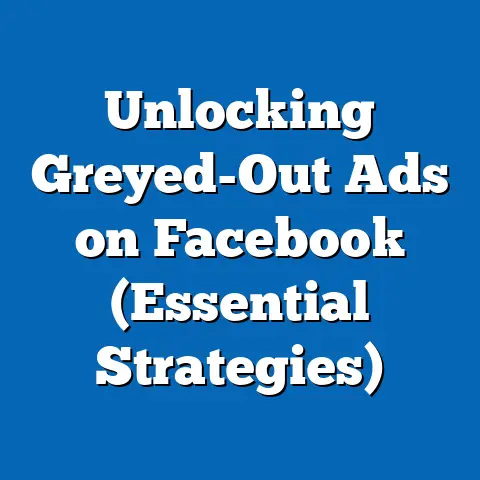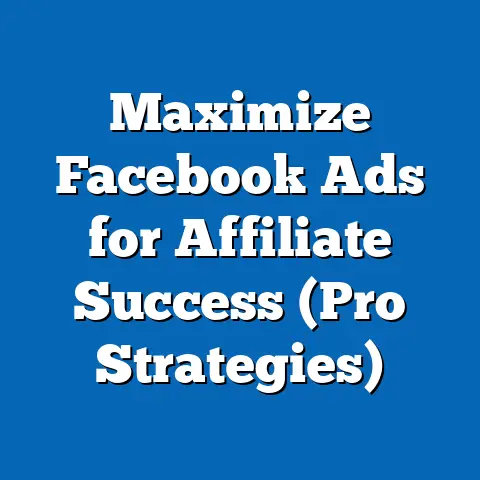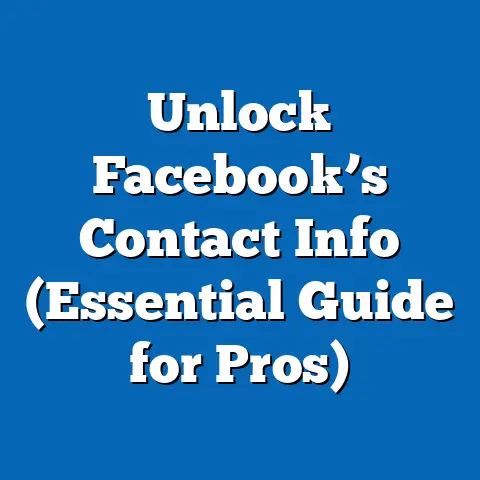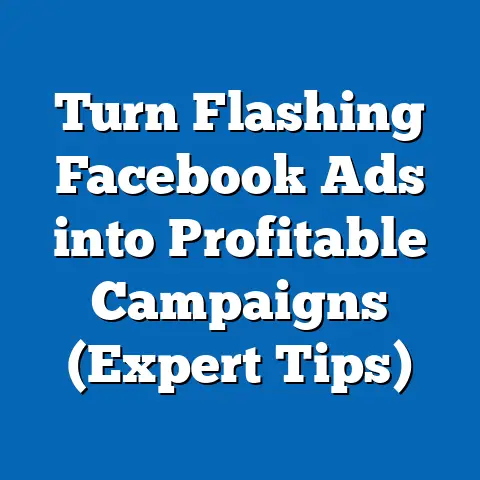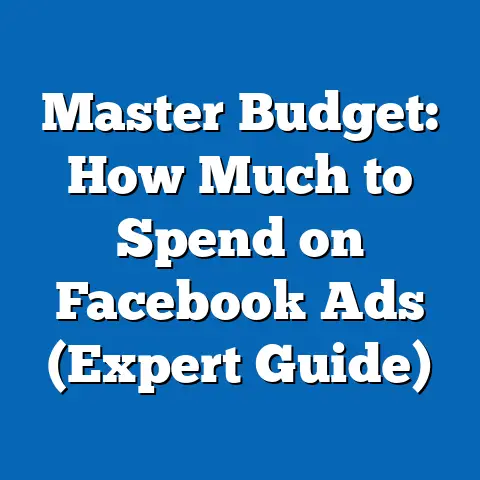Maximize Reach: Where to Run Facebook Ads (Expert Insights)
Ever find yourself caught in an unexpected downpour without an umbrella? Or squinting under a harsh sun without sunglasses? Just like the weather, the advertising landscape can shift unexpectedly, leaving your marketing efforts soaked or blinded. Knowing when to adjust your strategy – to “bring an umbrella” or “wear sunglasses” – is key to a successful campaign. That’s why understanding where to run your Facebook ads is so crucial.
Maximizing reach on Facebook isn’t just about blindly throwing money at the platform. It’s about strategic placement, understanding your audience, and adapting to the ever-changing algorithms. Choosing the right platforms and employing the right strategies can be the difference between a wildly successful campaign and a complete flop.
In this article, I’ll be diving into expert insights on where you should be running your Facebook ads to achieve maximum reach. I’ll share my experiences, data-backed strategies, and actionable tips to help you navigate the complex world of Facebook advertising and ensure your message reaches the people who matter most. Let’s get started!
Understanding Facebook as an Advertising Platform
Facebook, in its essence, is a colossal digital town square. Imagine a place where billions of people gather daily to connect, share, and discover. That’s Facebook. And within this bustling digital space lies an incredibly powerful advertising platform.
Overview of Facebook Advertising
Facebook advertising has come a long way since its early days. Remember those simple sidebar ads that felt more like afterthoughts than integral parts of the user experience? Today, Facebook’s advertising ecosystem is sophisticated, data-driven, and deeply integrated into the platform’s user interface.
From my perspective, the evolution of Facebook ads mirrors the evolution of the internet itself. It started as a basic tool and has transformed into a highly refined instrument. The key difference now is the sheer amount of data available to advertisers. Facebook knows its users inside and out – their interests, demographics, behaviors, and even their purchase histories. This wealth of information allows for incredibly precise targeting, making it possible to reach highly specific audiences with relevant messages.
Consider these stats:
- User Base: Facebook boasts nearly 3 billion monthly active users, making it the most popular social media platform globally.
- Engagement Rates: Despite the rise of newer platforms, Facebook still holds strong engagement rates, with users spending an average of 34 minutes per day on the platform.
- Ad Revenue: Facebook’s advertising revenue continues to grow, demonstrating the platform’s enduring value for businesses. In 2023, Facebook’s ad revenue reached over $116 billion.
These numbers aren’t just impressive; they’re indicative of the immense potential for reach that Facebook offers. But potential alone isn’t enough. To tap into this potential, you need to understand your audience.
Target Audience Analysis
Defining your target audience is the cornerstone of any successful Facebook advertising campaign. It’s like building a house – you wouldn’t start without a solid foundation, would you?
I’ve seen countless campaigns fail simply because the advertiser didn’t take the time to properly define their target audience. They cast a wide net, hoping to catch as many fish as possible, but ended up wasting money and resources on users who were never going to be interested in their product or service.
Facebook offers a wealth of targeting options that allow you to narrow down your audience based on:
- Demographics: Age, gender, location, education, job title, and more.
- Interests: Hobbies, passions, and topics they engage with on Facebook.
- Behaviors: Purchase history, device usage, travel habits, and other actions they take on and off Facebook.
- Connections: People who like your page, their friends, or users who have interacted with your content.
For example, let’s say you’re selling organic baby food. Instead of targeting all parents, you could target parents aged 25-35 who live in urban areas, are interested in organic food and healthy living, and have recently purchased baby products online. This level of precision dramatically increases the likelihood that your ads will resonate with your target audience.
Actionable Tip: Use Facebook’s Audience Insights tool to gain a deeper understanding of your existing customer base. Analyze their demographics, interests, and behaviors to create highly targeted audiences for your ad campaigns.
Different Ad Formats
Facebook offers a diverse range of ad formats, each designed to capture attention and drive engagement in different ways. Choosing the right ad format is crucial for maximizing reach and achieving your campaign goals.
Here’s a rundown of some of the most popular ad formats:
- Image Ads: Simple, clean, and effective for showcasing products or services with a compelling visual.
- Video Ads: Highly engaging and ideal for telling stories, demonstrating product features, or capturing attention with dynamic content.
- Carousel Ads: Allow you to showcase multiple products or features in a single ad, with users able to swipe through different images or videos.
- Collection Ads: Designed for e-commerce businesses, these ads feature a hero image or video followed by a selection of related products.
- Instant Experience Ads: Full-screen, mobile-optimized ads that provide an immersive experience for users, allowing them to browse products, watch videos, and explore interactive content.
- Lead Ads: Streamline the lead generation process by allowing users to submit their information directly within the ad, without being redirected to a landing page.
I’ve found that video ads consistently outperform image ads in terms of engagement and reach, especially when targeting younger audiences. However, the best ad format for your campaign will depend on your specific goals, target audience, and creative assets.
Actionable Tip: Experiment with different ad formats to see what resonates best with your target audience. Use A/B testing to compare the performance of different ad formats and optimize your campaigns accordingly.
Key Takeaway: Understanding Facebook as an advertising platform involves recognizing its massive user base, leveraging its precise targeting options, and experimenting with different ad formats to maximize reach and engagement.
Identifying the Right Locations for Ads
Now that you understand the Facebook advertising landscape, let’s zoom in on the specific locations where you can run your ads. Facebook offers a variety of placements, each with its own unique advantages and potential for reach.
Facebook News Feed
The Facebook News Feed is the primary location where users spend their time on the platform. It’s the digital equivalent of a town square, where people gather to see updates from friends, family, and businesses they follow.
Placing your ads in the News Feed offers significant potential for reach because it’s where users are most active and engaged. However, it’s also a highly competitive space, with countless businesses vying for attention. To stand out, your ads need to be visually appealing, relevant, and engaging.
I’ve learned that News Feed ads perform best when they seamlessly blend in with organic content. Avoid creating ads that look overtly promotional or salesy. Instead, focus on creating valuable content that provides information, entertains, or solves a problem for your target audience.
Actionable Tip: Use high-quality images or videos that capture attention and tell a compelling story. Write ad copy that is concise, clear, and relevant to your target audience. Include a strong call to action that encourages users to take the next step.
Instagram Integration
Facebook’s ownership of Instagram has opened up a world of possibilities for cross-platform advertising. Instagram is a highly visual platform with a younger, more engaged audience than Facebook. This makes it an ideal location for reaching millennials and Gen Z.
I often recommend that businesses consider running their Facebook ads on Instagram as well. The platform offers a variety of ad formats, including image ads, video ads, carousel ads, and story ads. Story ads, in particular, are a powerful way to capture attention and drive engagement with their immersive, full-screen format.
One of the biggest advantages of Instagram advertising is its visual nature. If you have high-quality images or videos, you can create incredibly compelling ads that resonate with your target audience.
Actionable Tip: Tailor your ad creative to the Instagram platform. Use visually appealing images or videos that capture attention and align with the platform’s aesthetic. Use relevant hashtags to increase the visibility of your ads.
Audience Network
The Facebook Audience Network extends the reach of your Facebook ads beyond the platform and into a network of third-party apps and websites. This allows you to reach users who may not be active on Facebook but are still part of your target audience.
The Audience Network offers a variety of ad formats, including banner ads, interstitial ads, and native ads. Native ads are designed to blend seamlessly into the surrounding content, making them less intrusive and more engaging for users.
I’ve found that the Audience Network can be a cost-effective way to increase the reach of your Facebook ads. However, it’s important to monitor the performance of your ads closely to ensure they are delivering the desired results.
Actionable Tip: Use automatic placements to allow Facebook to optimize your ad delivery across the Audience Network. Monitor the performance of your ads in different placements and adjust your bids accordingly.
Messenger Ads
Facebook Messenger is a messaging app with over 1.3 billion monthly active users. It’s a powerful platform for reaching customers directly and engaging them in personalized conversations.
Messenger ads can appear in the Messenger inbox, as sponsored messages within conversations, or as ads within Messenger Stories. These ads can be used to drive traffic to your website, generate leads, or promote your products or services.
I’ve seen businesses achieve great results with Messenger ads by using them to provide customer support, answer questions, or offer personalized recommendations. The key is to be helpful and engaging, rather than pushy or salesy.
Actionable Tip: Use Messenger ads to provide personalized customer support and answer questions. Offer exclusive deals or promotions to users who engage with your Messenger ads. Use chatbots to automate your Messenger interactions and provide instant responses.
Key Takeaway: Identifying the right locations for your Facebook ads involves understanding the unique advantages of each placement and tailoring your ad creative and targeting accordingly. Experiment with different placements to see what works best for your business and your target audience.
Leveraging Facebook Groups and Communities
Facebook Groups are digital communities where people with shared interests can connect, share information, and engage in discussions. These groups can be incredibly valuable for businesses looking to reach niche markets and engaged communities.
The Role of Facebook Groups
Facebook Groups offer a unique opportunity to connect with your target audience on a more personal level. Unlike traditional advertising, which is often perceived as intrusive or impersonal, group advertising allows you to engage in meaningful conversations and build relationships with potential customers.
I’ve seen businesses successfully use Facebook Groups to:
- Provide customer support: Answer questions, troubleshoot problems, and provide helpful advice to group members.
- Share valuable content: Share blog posts, articles, videos, and other content that is relevant to the group’s interests.
- Run contests and giveaways: Generate excitement and engagement by running contests or giveaways exclusively for group members.
- Gather feedback: Ask group members for their opinions on your products or services and use their feedback to improve your offerings.
The key to success in Facebook Groups is to be authentic and genuine. Don’t just join a group and start spamming it with ads. Instead, take the time to build relationships with group members, participate in discussions, and provide valuable content.
Strategies for Group Advertising
Advertising in Facebook Groups requires a delicate touch. You don’t want to come across as spammy or self-promotional. Instead, you want to be seen as a valuable member of the community who is genuinely interested in helping others.
Here are some best practices for advertising in Facebook Groups:
- Choose the right groups: Select groups that are relevant to your business and target audience.
- Read the group rules: Make sure you understand the group’s rules and guidelines before posting anything.
- Introduce yourself: Introduce yourself to the group and explain why you’re interested in joining.
- Participate in discussions: Engage in meaningful conversations with group members and provide valuable insights.
- Share valuable content: Share blog posts, articles, videos, and other content that is relevant to the group’s interests.
- Promote your business sparingly: Only promote your business when it’s relevant to the discussion and you have something valuable to offer.
I’ve found that the most effective way to advertise in Facebook Groups is to focus on providing value and building relationships. When you genuinely care about helping others, they’re more likely to be receptive to your message.
Case Studies
Let’s take a look at some examples of successful campaigns that leveraged Facebook Groups for maximum reach:
- A local bakery: Joined a local community group and started sharing photos of their delicious pastries. They also offered exclusive discounts to group members. As a result, they saw a significant increase in foot traffic and sales.
- A fitness coach: Joined a health and wellness group and started sharing workout tips and healthy recipes. They also offered free consultations to group members. As a result, they gained a number of new clients.
- A software company: Joined a group for entrepreneurs and started sharing helpful articles about business growth. They also offered a free trial of their software to group members. As a result, they generated a number of qualified leads.
These case studies demonstrate the power of Facebook Groups for reaching niche markets and engaged communities. By providing value, building relationships, and promoting your business sparingly, you can achieve great results.
Key Takeaway: Facebook Groups offer a unique opportunity to connect with your target audience on a more personal level. By participating in discussions, sharing valuable content, and promoting your business sparingly, you can achieve maximum reach and build lasting relationships with potential customers.
Utilizing Lookalike Audiences and Retargeting
Now, let’s talk about two incredibly powerful tools that can significantly expand your reach and improve the effectiveness of your Facebook ad campaigns: lookalike audiences and retargeting.
Understanding Lookalike Audiences
Lookalike audiences are one of my favorite features on Facebook. They allow you to reach new people who are similar to your existing customers. Think of it as cloning your best customers and targeting them with your ads.
Facebook uses its vast trove of data to identify the characteristics, interests, and behaviors of your existing customers. It then finds other users who share those same characteristics, interests, and behaviors. These users are your lookalike audience.
I’ve seen businesses achieve incredible results with lookalike audiences. By targeting people who are similar to their best customers, they’re able to reach a highly qualified audience that is more likely to be interested in their products or services.
Actionable Tip: Start with a seed audience of at least 1,000 of your best customers. The larger and more accurate your seed audience, the better your lookalike audience will be.
Retargeting Strategies
Retargeting is the process of showing ads to people who have previously interacted with your business. This could include people who have visited your website, watched your videos, or engaged with your Facebook page.
Retargeting is incredibly effective because it allows you to re-engage people who have already shown an interest in your business. These people are more likely to be receptive to your message and more likely to convert into customers.
I always tell my clients that retargeting is like following up with a potential customer after a sales meeting. You’re reminding them of your business and giving them another opportunity to take the next step.
Actionable Tip: Create different retargeting audiences based on the specific actions people have taken. For example, you could create a retargeting audience of people who have visited your website but haven’t made a purchase. You could then show these people ads that offer a discount or free shipping.
Best Practices
Here are some best practices for creating effective lookalike audiences and retargeting campaigns:
- Use high-quality seed audiences: The quality of your lookalike audience depends on the quality of your seed audience. Make sure your seed audience is accurate and representative of your best customers.
- Segment your retargeting audiences: Don’t just create one retargeting audience for everyone who has visited your website. Segment your audiences based on their specific actions.
- Tailor your ad creative: Tailor your ad creative to the specific audience you’re targeting. Use different images, videos, and ad copy for different audiences.
- Test different offers: Test different offers to see what resonates best with your target audience. Offer discounts, free shipping, or other incentives.
- Monitor your results: Monitor your results closely and adjust your campaigns accordingly. Track your conversion rates, cost per acquisition, and other key metrics.
Key Takeaway: Lookalike audiences and retargeting are powerful tools for expanding your reach and improving the effectiveness of your Facebook ad campaigns. By using these tools effectively, you can reach a highly qualified audience that is more likely to be interested in your products or services.
Timing and Frequency of Ads
Timing, as they say, is everything. And it’s definitely crucial when it comes to maximizing the reach of your Facebook ads. Similarly, how often you show your ads can make or break your campaign.
Optimal Timing for Ads
Think about it: are people glued to their phones at 3 AM on a Tuesday? Probably not. Understanding when your target audience is most active on Facebook is key to ensuring your ads are seen by the right people at the right time.
I’ve found that peak times for user engagement often vary depending on your target audience and industry. However, some general guidelines apply:
- Weekdays: People tend to be more active on Facebook during weekdays, especially during lunch breaks and after work hours.
- Weekends: Engagement can be higher on weekends, but it’s important to consider that people may be spending more time offline or engaging in other activities.
- Specific Industries: If you’re targeting parents, you may find that they’re more active during early morning hours or late at night, when their kids are asleep.
Facebook provides data on when your audience is most active, so be sure to leverage this information to schedule your ads accordingly.
Actionable Tip: Use Facebook’s ad scheduling feature to run your ads during peak times for user engagement. Experiment with different time slots to see what works best for your target audience.
Ad Frequency
There’s a fine line between showing your ads frequently enough to stay top-of-mind and showing them so often that you annoy your audience. Ad frequency refers to the average number of times a user sees your ad.
If your ad frequency is too low, you may not be making enough of an impact. But if it’s too high, you risk causing ad fatigue, which can lead to lower engagement rates and even negative sentiment towards your brand.
I’ve learned that the ideal ad frequency depends on several factors, including your target audience, ad creative, and campaign goals. However, as a general rule of thumb, aim for an ad frequency of between 2 and 5.
Actionable Tip: Monitor your ad frequency closely and adjust your campaign settings accordingly. If you notice that your engagement rates are declining or that people are starting to hide your ads, reduce your ad frequency.
Key Takeaway: Timing and frequency are crucial factors in maximizing the reach of your Facebook ads. By scheduling your ads to run during peak times for user engagement and maintaining a healthy ad frequency, you can increase the likelihood that your ads will be seen by the right people at the right time.
Measuring and Analyzing Reach
You’ve put in the work, crafted compelling ads, and targeted the right audience. But how do you know if your efforts are paying off? That’s where measuring and analyzing reach comes in.
Key Metrics to Track
Tracking the right metrics is essential for understanding the performance of your Facebook ad campaigns and making data-driven decisions. Here are some of the most important metrics to track:
- Impressions: The number of times your ad was shown to users.
- Reach: The number of unique users who saw your ad.
- Engagement Rate: The percentage of users who interacted with your ad (e.g., likes, comments, shares).
- Click-Through Rate (CTR): The percentage of users who clicked on your ad.
- Cost Per Click (CPC): The average cost you paid for each click on your ad.
- Conversion Rate: The percentage of users who took a desired action after clicking on your ad (e.g., made a purchase, filled out a form).
- Return on Ad Spend (ROAS): The amount of revenue you generated for every dollar you spent on advertising.
I always advise my clients to focus on the metrics that are most relevant to their business goals. If your goal is to increase brand awareness, then you should focus on impressions and reach. If your goal is to generate leads, then you should focus on conversion rate and cost per acquisition.
Using Facebook Insights
Facebook Insights is a powerful tool that provides valuable data about your audience, your content, and your ad performance. You can use Facebook Insights to:
- Understand your audience: Learn about their demographics, interests, and behaviors.
- Analyze your content: See which posts are performing best and what types of content resonate most with your audience.
- Track your ad performance: Monitor your key metrics and identify areas for improvement.
I use Facebook Insights on a daily basis to monitor the performance of my ad campaigns and make data-driven decisions. It’s an invaluable resource for understanding what’s working and what’s not.
Actionable Tip: Regularly review your Facebook Insights data to identify trends and patterns. Use this information to optimize your ad campaigns and improve your results.
Adjusting Strategies Based on Data
The beauty of Facebook advertising is that it’s incredibly flexible. You can adjust your strategies in real-time based on the data you’re seeing.
If you notice that your ads aren’t performing as well as you’d like, don’t be afraid to make changes. This could include:
- Adjusting your targeting: Try targeting different demographics, interests, or behaviors.
- Changing your ad creative: Experiment with different images, videos, and ad copy.
- Optimizing your bids: Adjust your bids to increase your chances of winning the auction.
- Pausing underperforming ads: Don’t be afraid to pause ads that aren’t delivering the desired results.
I’ve seen campaigns completely turn around simply by making a few small adjustments based on data. The key is to be proactive and constantly monitor your results.
Key Takeaway: Measuring and analyzing reach is essential for understanding the performance of your Facebook ad campaigns and making data-driven decisions. By tracking the right metrics, using Facebook Insights, and adjusting your strategies based on data, you can continuously maximize your reach and improve your results.
Conclusion
Navigating the world of Facebook advertising can feel like forecasting the weather – unpredictable and sometimes downright frustrating. But just as a seasoned meteorologist relies on data and experience to make accurate predictions, so too can you leverage expert insights and proven strategies to maximize your reach on Facebook.
Recap Key Points
Throughout this article, we’ve explored the importance of understanding Facebook as an advertising platform, identifying the right locations for your ads, leveraging Facebook Groups and communities, utilizing lookalike audiences and retargeting, optimizing timing and frequency, and measuring and analyzing reach.
Remember, maximizing reach on Facebook isn’t about blindly throwing money at the platform. It’s about strategic placement, understanding your audience, and adapting to the ever-changing algorithms.
Future of Facebook Advertising
The future of Facebook advertising is likely to be even more data-driven and personalized. As artificial intelligence and machine learning continue to evolve, Facebook will be able to provide even more precise targeting options and deliver even more relevant ads to users.
We can also expect to see more emphasis on video and interactive content, as these formats become increasingly popular with users. And as Facebook continues to expand its e-commerce capabilities, we can expect to see more opportunities for businesses to sell their products and services directly on the platform.
Final Thoughts
The world of Facebook advertising is constantly evolving, and it’s important to stay adaptable and informed. By continuously learning, experimenting, and analyzing your results, you can stay ahead of the curve and achieve maximum reach for your business.
Don’t be afraid to try new things, to challenge the status quo, and to push the boundaries of what’s possible. With the right mindset and the right strategies, you can achieve incredible results on Facebook.
So, go out there, brave the storm, and make your mark on the world of Facebook advertising!

